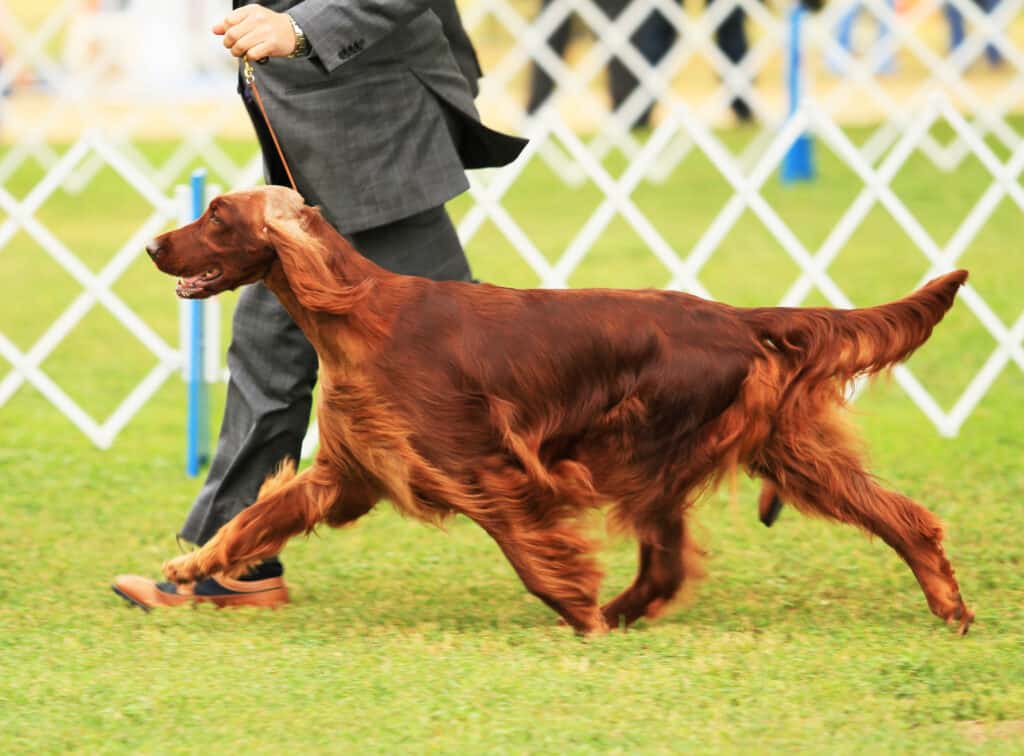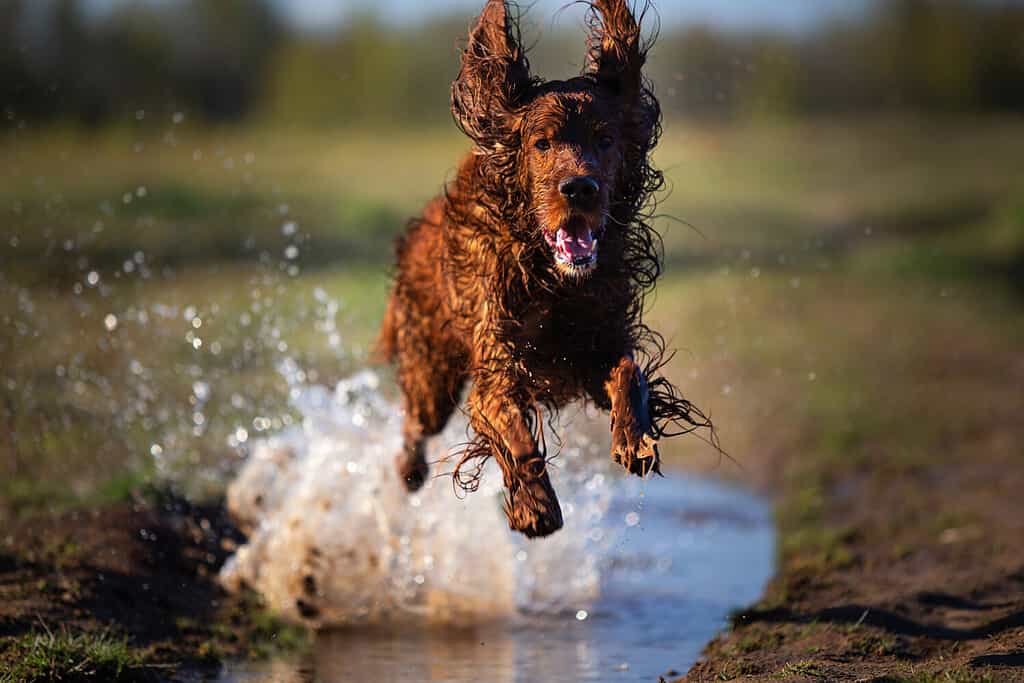All dogs come with health problems that are specific to their breed. Like humans, dogs are prone to genetic conditions they can inherit from their parents! Irish setters are susceptible to an extensive list of issues that potential owners must know. Read on to learn more about common health problems you might see in the Irish setter breed.

Irish setters were initially bred for bird hunting.
©Canden Scales/Shutterstock.com
1. Hypothyroidism
One of the most common diseases seen across the Irish setter breed would have to be hypothyroidism. Thyroid issues are common in this breed. Signs of this disease include dull coats, loss of hair, dry skin, weight gain leading to obesity, lethargy, and more. The reason is that the thyroid is in control of producing hormones that are crucial for a balanced and healthy body. When your setter has hypothyroidism, it’s because their thyroid doesn’t secrete enough thyroid hormones and, in turn, severely affects its metabolism by slowing it down. The good news is that this disease is highly treatable. Your pet will likely be on an oral synthetic thyroid hormone replacement for the rest of their lives, but this will make all of your pet’s symptoms disappear or become more easily manageable.
2. Von Willebrand Disease I (VWDI)

Unfortunately, Irish setters commonly suffer from a disease that affects their blood’s clotting ability.
©Reddogs/Shutterstock.com
Many inheritable diseases are across numerous different breeds. Von Willebrand Disease I (VWDI) often appears in these breeds:
- Doberman Pinschers
- Pembroke Welsh Corgis
- Poodles
- Bernese Mountain Dogs
- West Highland White Terriers
Though you might find this disease in other breeds, it commonly afflicts Irish red and white setters. VWDI affects blood’s ability to clot due to a lack of an essential protein. While not necessarily fatal, it’s still a concern for many pet owners. Keep an eye out for bruising, nose bleeds, and longer recovery times after trauma or surgery.
3. Canine leukocyte adhesion deficiency (CLAD)
Breed-specific gene mutations cause the next item on the list and can affect Irish setters and German shepherds. Recurrent bacterial infections due to abnormal white blood cell activity characterize this inherited immunodeficiency disease. Your pet will likely battle infections such as pneumonia, omphalitis, peritonitis, gingivitis, and more. You might also notice lameness, lesions, and ulcers, too. Dogs with this health disorder will have to live their lives with a severely impaired immune system. Most breeders opt for genetic screening for the CD18 gene to prevent it from breeding into further generations.
4. Gastric Dilatation-Volvulus Syndrome (GDV) or Bloat

GDV usually occurs after a big meal or intense exercise.
©SeventyFour/iStock via Getty Images
Known as one of the most painful syndromes, Gastric Dilatation-Volvulus Syndrome (GDV) is a common condition for Irish setters. It’s mostly common among dogs with a large body size and deep chest. Almost 25% of setters will experience this life-threatening condition, and over 7% will perish from it. Unless treated quickly, this condition is fatal within hours of onset.
Sometimes referred to simply as “bloat,” this issue appears as a distended stomach filled with gas and fluid. This can lead to a rotation of the stomach on its axis anywhere between 180 to 360 degrees. This rotation can lead to a blocked blood flow, which affects the heart’s ability to function properly and can lead to shock. Some symptoms of this syndrome include unproductive vomiting, pacing and restlessness, and collapse.
5. Epilepsy

Irish setters are one of the breeds most susceptible to Idiopathic epilepsy (IE).
©DragoNika/Shutterstock.com
The Irish setter commonly inherits Idiopathic epilepsy (IE). In fact, setters are at a higher risk than many other breeds to inherit this health issue. Your dog might experience a seizure as early as six months old, though some dogs don’t display a seizure until they’re three years old. Here are some symptoms of a seizure:
- Stiffening of the body
- Collapse and falling over to the side
- Chewing or chomping motion
- Salivation and drooling
- Paddling of the legs
- Loss of urine or feces
- Vocalizing
- Loss of consciousness
- Muscle twitching
- Foaming at the mouth
Treatment of IE often includes an anti-epileptic drug (AED), an anticonvulsant, and other supplements. Some veterinarians might suggest surgery, though they can’t guarantee results. While there isn’t a cure for epilepsy isn’t curable, it’s possible to manage with medication.
6. Hip dysplasia

Displaysia can occur not only in the hips but the elbows as well.
©Wirestock/iStock via Getty Images
Since Irish setters are prone to hip dysplasia, preventing the condition from developing is impossible. If your Irish setter has inherited this issue, you might notice several symptoms from a young age. This common health issue is due to the abnormal development of your dog’s affected joint. Letting a condition like this linger will often lead to arthritis. The most common way to treat it is through reconstruction of the hip joint through surgery. Anti-inflammatory medications or corticosteroids can relieve pain but won’t cure the condition.
7. Osteosarcoma

Check for swelling and lameness in your dog’s legs, as these symptoms can be a sign of osteosarcoma.
©Alex Zotov/Shutterstock.com
The disease known as osteosarcoma is a malignant cancer that can affect several different breeds. It can be challenging to diagnose because there aren’t clear symptoms in the early stages of the disease. The most common spots for these tumors to appear are the proximal humerus and tibia, distal femur, and radius. Knowing your dog’s normal behavior and being in tune with them can help you notice when something is amiss. Some early symptoms can include lameness or swelling in an appendage, fevers, and weight loss due to reduced appetite. The most effective way to treat this disease is through amputation in tandem with chemotherapy.
8. Progressive retinal atrophy (PRA)
If your Irish setter was born with this disease, they will experience total blindness before they reach two years of age. Often, your veterinarian can diagnose this in your dog as early as six weeks old. According to UC Davis’s Veterinary Genetics Laboratory, this inherited rod-cone dysplasia comes from a mutation of the phosphodiesterase 6B enzyme. Your veterinarian can run a DNA-based blood test to confirm the disease. Some early signs of PRA in dogs include night blindness, reluctance to enter dark rooms, dilated pupils, and clumsiness. There is no effective treatment for PRA, so it’s crucial to create an environment in your home suitable for blindness in dogs.
The photo featured at the top of this post is © Giuseppe Paolo Mannino/iStock via Getty Images
Ready to discover the top 10 cutest dog breeds in the entire world?
How about the fastest dogs, the largest dogs and those that are -- quite frankly -- just the kindest dogs on the planet? Each day, AZ Animals sends out lists just like this to our thousands of email subscribers. And the best part? It's FREE. Join today by entering your email below.
Thank you for reading! Have some feedback for us? Contact the AZ Animals editorial team.






